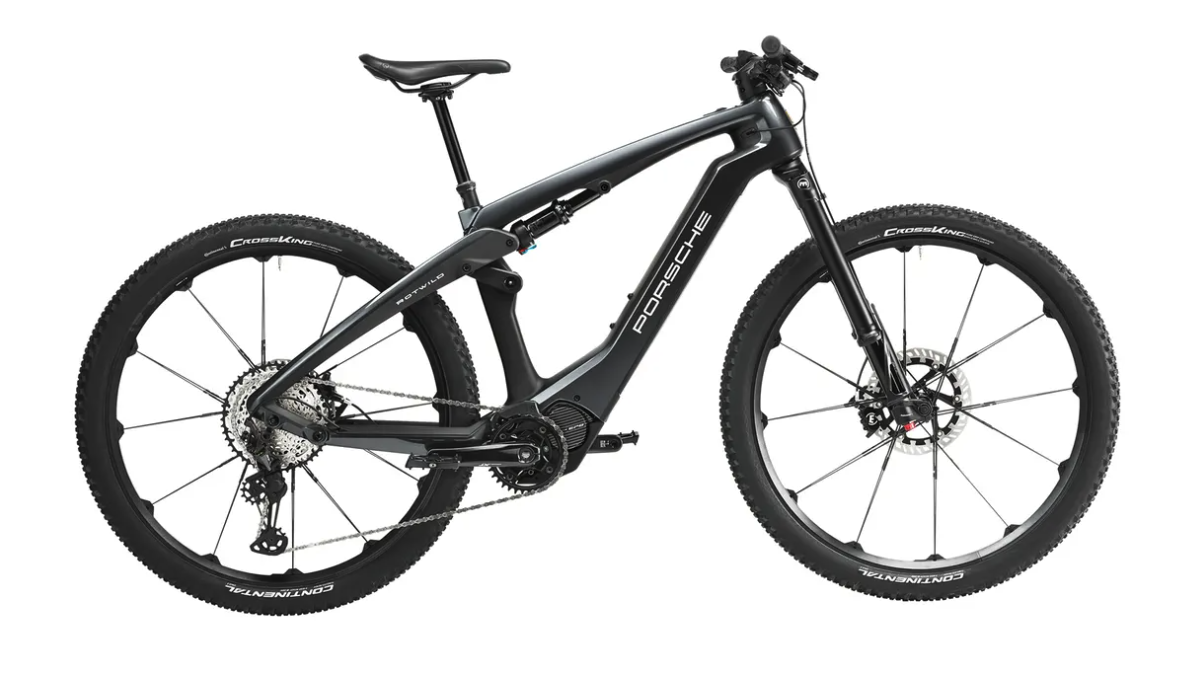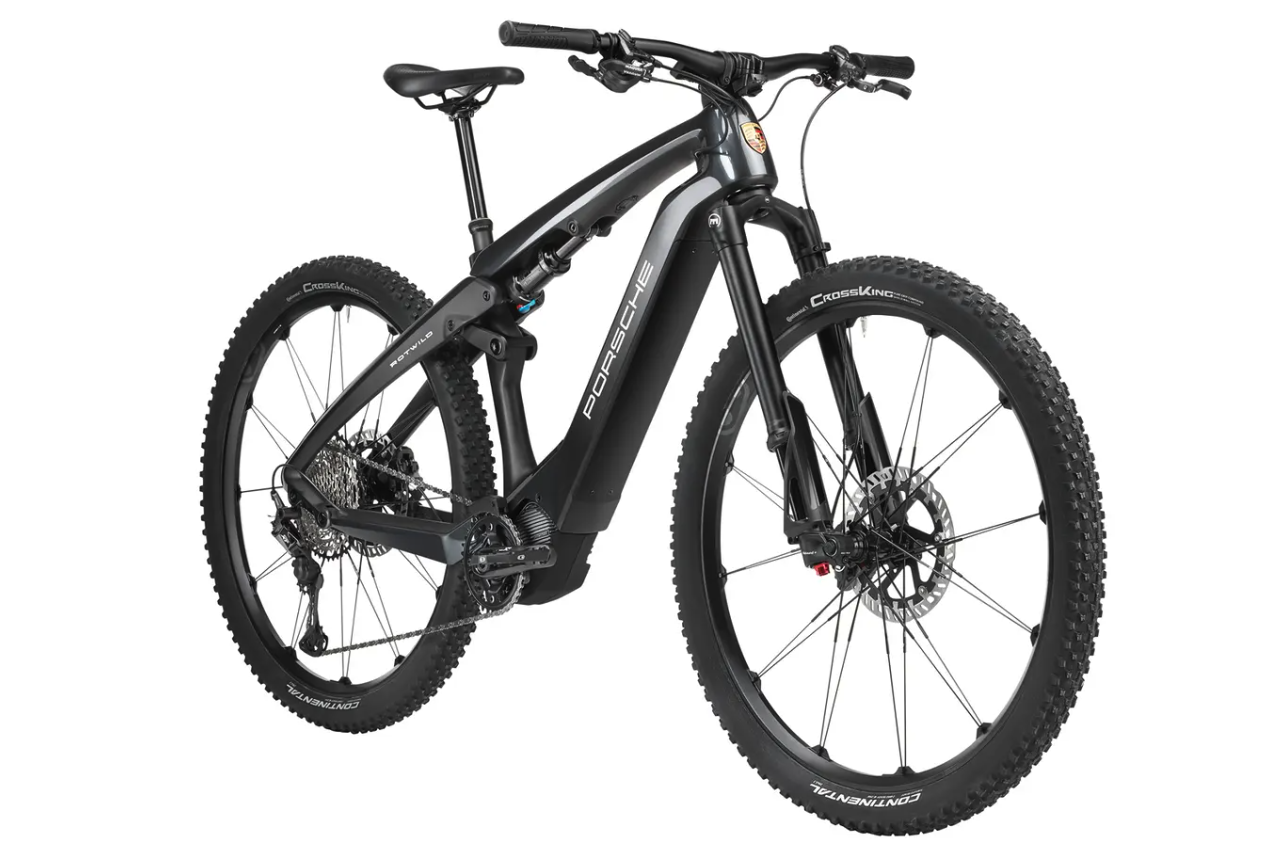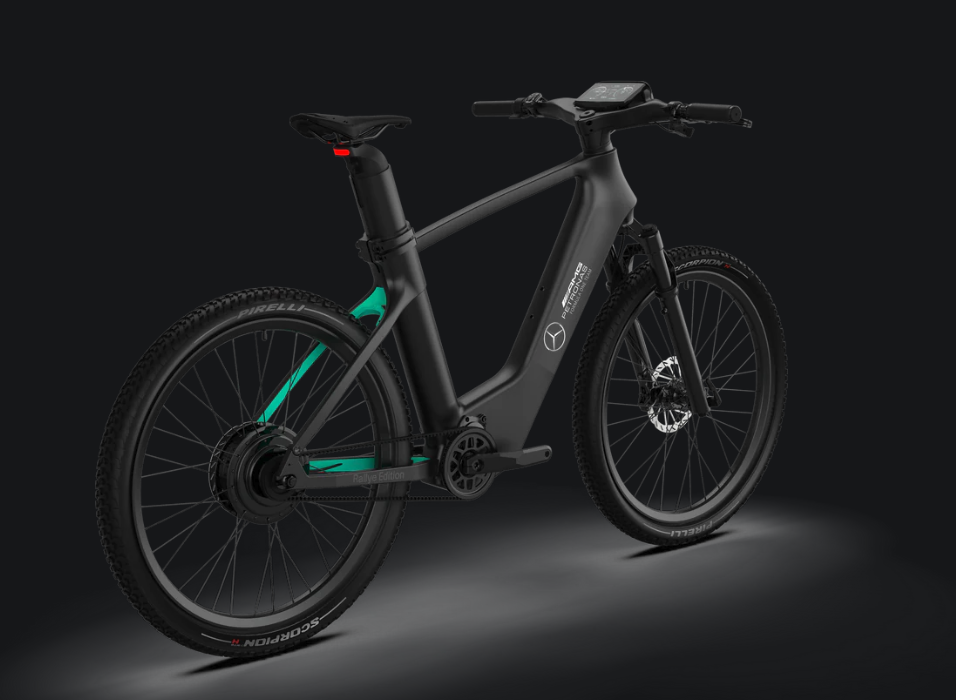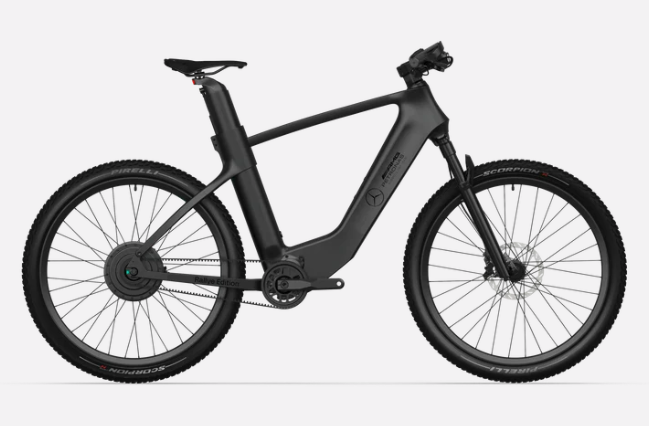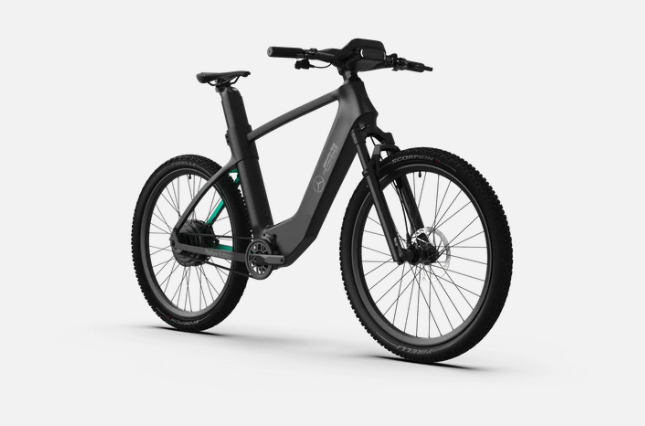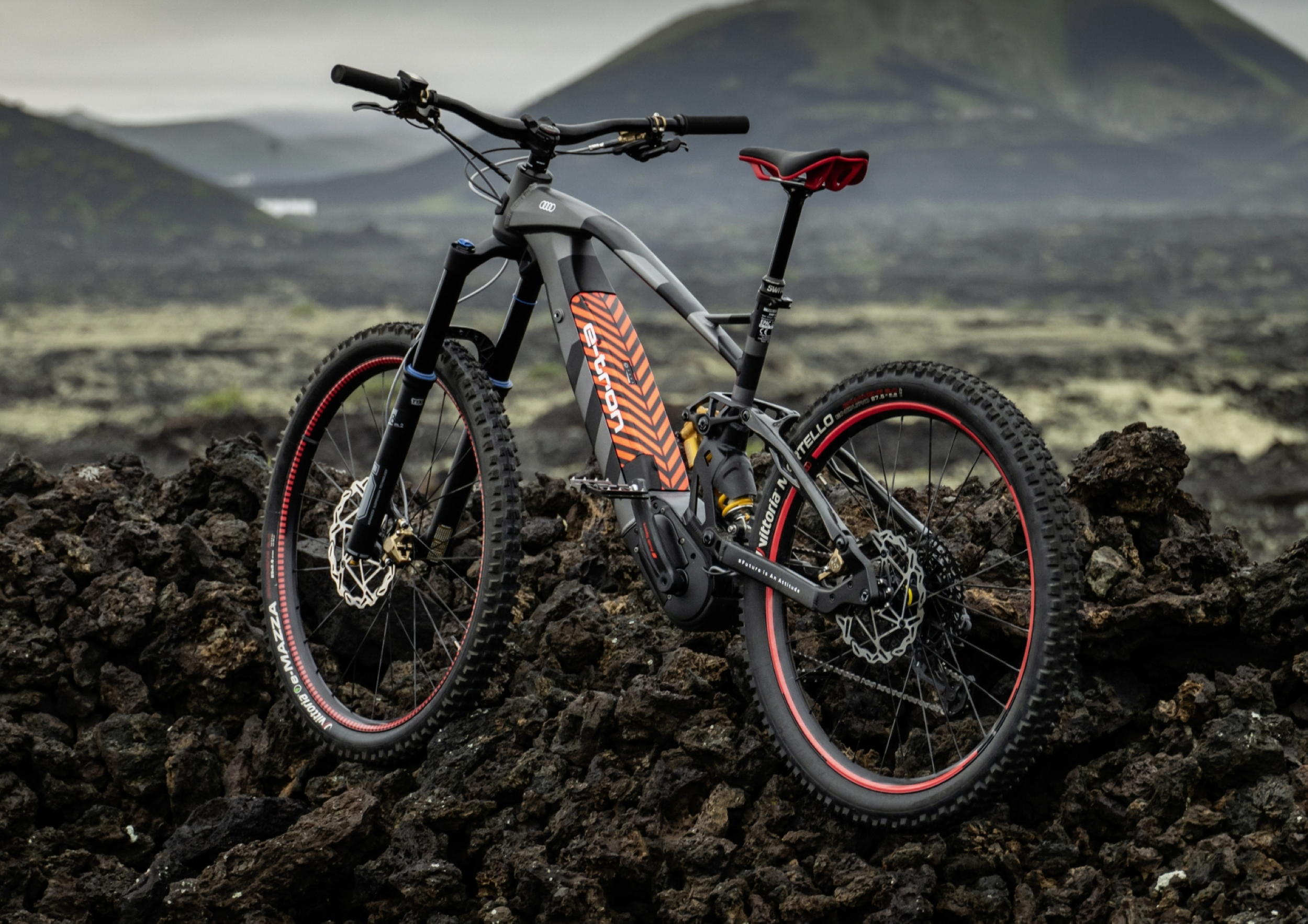Headlines were made and riders around the world were shocked recently when
Mclaren launched its eccentric Extreme 600 e-bike, but the Woking supercar brand and F1 team is not the first car manufacturer to dip its toe into the muddy waters of mountain biking. From Porsche to Lamborghini, via Lotus and Audi, pretty much every luxury car brand has tried to join the lifestyle dots between two and four wheels… with varying degrees of success.

The McLaren Extreme 600 e-bike gets a lot right – mullet wheels, smart components – but goes a little off-piste with the handlebar display and integrated lighting.
In the past, it was usually a case of lazy, half-baked licensing deals with established bike manufacturers – including some painfully embarrassing case studies involving none other than Ferrari – and while this continues to some extent, most car brands have sought to put their own engineering and creative stamp on the bikes bearing their names. Again, this has produced some wildly varying results, that – as in the case of the McLaren’s handlebars – can be more about standing out from the crowd than offering what mountain bikers actually want. But we’re making one massively erroneous assumption here; that these performance car brands care one iota about what mountain bikers think, or whether we actually end up buying any of their bikes. Of course they don’t. They want to sell to the type of customer that might buy one to get around the marina where his or her yacht is moored, or to take a leisurely tour of their sprawling country estate, not to pull off the roof of their McLaren Artura in the car park at BikePark Wales.

Yes, these are the McLaren’s stock handlebars, and they remind us of an old Raleigh Quasar from the 80s.
While we jest about the target customer, and some of the more outlandish design details, we actually welcome the presence of these household marques in the marketplace. It shows that mountain biking is on the radar for these massive, multi-billion dollar businesses, which means the people running them either think it’s cool – maybe some of them are riders – or they see a financial or marketing opportunity. Just look at the relative scale of Porsche compared to Specialized; in 2023 Porsche revenue was £35bn, for Specialized it was £400m. Which makes Porsche 87 times bigger than Specialized. Down the line that could mean cash for the bike industry, potentially through sponsorship of race teams or race series. Maybe even funding for new trails.
But enough general chat, let’s take a look at the bikes themselves. Some are historic models, and some are on sale today. But the thing that ties them altogether is that they are all truly unique designs.

Porsche’s E-Bike Cross was built with the help of Rotwild, and is fairly restrained as far as a bike styled by a car designer goes.
Porsche E-Bike Cross
Although no longer available, Porsche’s E-Bike Cross fairly successfully walked the tightrope between looking like a conventional mountain bike, and something futuristic and conceptual. Maybe that’s because the Stuttgart sports car brand enlisted the help of Rotwild bikes to assist with the design and engineering. The styling was done in-house at Studio Porsche, and the designers have been remarkably restrained when you look at some of the creations their industry colleagues have penned. It still has that classic double-diamond bicycle frame, with the shock tucked under the top tube. Even if the frame is a heavily styled and sculpted carbon monocoque, with sweeping lines from the rear dropout all the way up to the bulging head tube.

Upside down Magura forks are a highlight, or lowlight, depending on your perspective.
Rather than its signature flat six motor in the back, Porsche went with a mid-mounted Shimano EP8 unit on the E-Bike Cross, paired with a meagre 504Wh battery (perhaps for weight saving?). When it came to the specification, Porsche couldn’t resist going pretty left-field. Like so many bike brands, it fell into the trap of prioritising style over function, with an upside-down Magura fork (with only 100mm travel), Crankbrothers old Cobalt wheels, and lightly treaded Continental tyres. All of which reinforces the theory that these bikes will rarely go off-road. A bit like the majority of Porsche Cayenne SUVs, then.

With a single-sided chainstay, and internal gearbox, the Lamborghini Crosser is certainly innovative. Then someone thought the finishing touch it always needed was a kickstand.
Lamborghini Crosser E-Bike
When Lamborghini announced it was entering the e-bike market back in 2018, it shamelessly tugged on the heartstrings of every 80’s child by conspicuously photographing the bike in front of a bright green Countach. I mean, who can blame them? Sadly the two-wheel raging bull was not quite as sweet in the eye-candy stakes as that beautiful mid-engined wedge. More saggy heifer than raging bull…

From a brand that built the stunning Countach, comes the Crosser e-bike.
The most eye-catching feature on the Lambo e-bike (designed by Ital-Bike) was the fully enclosed drivetrain. Hidden within that Dutch-style chain guard is an 8-speed gearbox and 500W motor. It’s also a single-sided chainstay, like a motorcycle, but contrary to all visual signals, the Lamborghini is actually a hardtail, not a full-suspension design. Sneaky blighters. What can I say about the Lamborghini e-bike that’s positive? Possibly the only thing that comes to mind is that it’s not actually on sale any more.

The Mercedes AMG F1 Rallye Edition gets a dashboard straight out of an S-Class.
Mercedes AMG F1 Rallye Edition
Mercedes has leaned heavily into its F1 connections to promote its N+ e-bike range, with talk of motorsport-inspired technology and optimised performance. While the majority of bikes offered are road models, there is a Rallye Edition that seems geared up for off-road use. Although, like the Lamborghini, it’s a hardtail with an 80mm travel suspension fork, so perhaps not fully optimised for the sort of off-road riding considered mountain biking.

We’ve got no idea why the Mercedes’ seat tube is so massive.
Where to start, where to start… The Mercedes AMG F1 Rallye Edition has so many USPs that it’s hard to know what to delve into first. So i’ll kick off with the gearbox drivetrain – a Pinion C 1.9 unit with nine ratios and electronic shifting. But rather than fit the latest Pinion MGU – Motor Gearbox Unit, where the drive unit and gearing is combined – Mercedes has used a rear hub motor. These are popular on road e-bikes, but pretty terrible for mountain biking as they put the weight in totally the wrong place for optimised handling. Surely the team that design the Mercedes F1 car should know that?

Possibly not its best angle: The Mercedes AMG F1 Rallye Edition
Like the McLaren e-bike, Mercedes has designed an outlandish cockpit with integrated 5.5in display (we’re not sure if the speedo reads up to 200mph). Although Mercedes goes one step further by linking it to the included smart helmet via Bluetooth, and there are also automatic headlights, brake lights, and even turn signals. And while the rider can enjoy a data-rich telemetry experience, I couldn’t find information anywhere on the website about the frame material, or why the seat tube is as thick as a lamppost.

Audi proves that you don’t need to treat your bike design like a final year degree project.
Audi Electric Mountain Bike Powered By Fantic
Leveraging it’s success in the Dakar Rally, Audi has partnered with e-bike brand Fantic for its two-wheel effort. And it’s a sensible strategy, going by some of other bikes in this list, since it’s little more than a sticker and a paint job. At the heart of the Audi e-bike is a Brose motor (as used in the
Specialized Turbo Levo) allied to a SRAM wireless AXS drivetrain, and there’s some tasty Ohlins suspension to reinforce the off-road motorsports connection. With 180mm of travel, this is a serious beast, designed for proper riding on alpine trails and bike parks. It costs £8,499, which appears to be about a £400 premium over the equivalent Fantic XEF model.

Old, but still futuristic: the carbon monocoque Lotus mountain bike from 1992.
Lotus Monocoque Carbon Mountain Bike
We had to dig into the archive for this one, as even though the Norfolk lightweight sports car brand has been synonymous with cycling at the highest levels recently, that’s only been on the track, rather than off-road. The Lotus mountain bike was the first monocoque carbon MTB ever produced, way back in 1992. We know this because we bumped into its designer, Chris Hornzee-Jones, riding on the South Downs a few years ago. And he was aboard the distinctive ‘leaping dolphin’ design – one of just 400 built. The story of the bike is a fascinating one, including secretive arms companies, scuba diving in the Bahamas, and 1mm thin titanium dropouts, and you can read all about it here.

Trust Polestar to deliver a chic, ice cool down-country bike for its two-wheel tie-in.
Polestar Editon Allebike
Maybe not in the same league as Lamborghini and Porsche, but Polestar has become the new architect’s car of choice in recent years, and its collaborative mountain bike spin-off is as ice cool as you’d expect from the Scandi brand. Basically an
Allebike down-country chassis with Ohlins suspension, the Polestar Edition was limited to just 100 bikes. It looks decent – read normal – but I couldn’t help thinking that as an electric car brand, Polestar missed an opportunity not building an e-bike.


